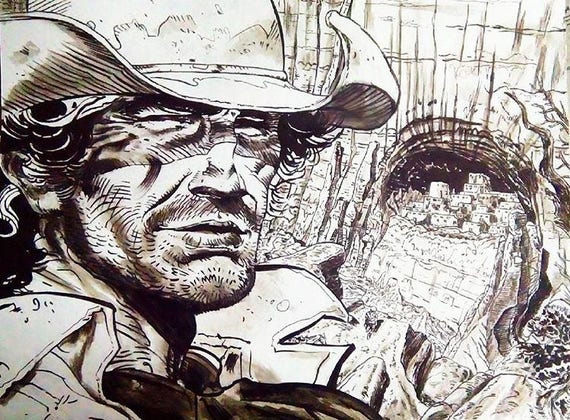
Ever since I was a kid, I’ve had this insatiable curiosity about the fantastic and the unknown. Naturally, the world of imagination and fantasy was something that blossomed in me like an insidious weed, one that stubbornly remains to this day, growing ever larger and more entrenched.
With that in mind, the figure of Jean Giraud was not only someone who’s work I loved as a child, but one that I now admire for different reasons as an adult.
Giraud was someone who made it in illustration as somewhat of a chameleon. In Europe, he’s one of the most well respected artists in the Franco-Belgian bandes dessinées tradition, cutting his teeth with the realism-leaning Western series Blueberry in conjunction with co-creator Jean-Michel Charlier. Nowadays he along with Herge of Tin Tin fame are considered the most influential artists of the Franco-Belgian sequential art world.

What’s interesting to me is that Giraud was never quite satisfied with solely exploring settings more traditionally rooted in realism, but wasn’t finding he could branch out the way he wanted to under his own name. The pseudonym “Moebius” was adopted, allowing him to branch out and experiment while still working on his mainstay in the form of Blueberry.


What I love about this side of him is how unapologetically weird it can be. The fantastic landscapes and characters he conjured have become synonymous with French science-fiction, influencing some of my favorite later works like Thorgal, Orbital and Empire of a Thousand Planets as well as his own works on series such as The Incal. A large part of the aesthetic of science fiction through the 60s onwards, particularly in Europe was influenced by his works, often through the French Metal Hurlant magazine.


As an aside, something I found quite funny was his partner
Jean-Michel Charlier (with whom he was making Blueberry with) didn’t understand why he would ever want to make these “weird” scenes under Moebius, and didn’t think they were worthwhile but decided to accept his friend’s endeavour with the statement, “every artist needs a mental shower, I suppose”. Interesting indeed then that Giraud’s so-called shower would go on to become one of the most loved endeavors of illustration in the world of sci-fi and comics.
Sourcing:
https://freight.cargocollective.com/w/600/i/d4b9d7ea34d0eae84f72a5739f186da7a0cd0602bbccbc9770bad0b1c3d88d0e/moebius-5_o.jpg
http://www.dieselfunk.com/category/heavy-metal/
https://butdoesitfloat.com/Art-is-the-big-door-but-real-life-is-a-lot-of-small-doors-that-you
https://www.expeditionart.org/blog-content1/2015/4/17/jean-giraud-moebius-1938-2012
https://marciokenobi.wordpress.com/2012/03/10/r-i-p-jean-giraud-moebius/

February 12, 2019 at 9:22 am
John,
Good work on both these illustrators but my only question is that Moebius is a much later illustrator, more in the 1970s era. Will you be circling back to cover an illustrator from the era of lecture 4, Golden Age II? That said your writing and personal in-put on the illustrators you cover is top shelf.
Jeff
February 16, 2019 at 2:12 pm
Jeff,
I can certainly circle back an era and write on another one for the next post, no worries! I knew he was a little later and might be pushing it, he’s just one I very much wanted to write on at some point. Will have an earlier illustrator for you on the next post!
John
February 24, 2019 at 1:30 pm
John,
Just checking in today, Sunday, Feb. 24th and looking for more posts but see nothing new. Best not to get to far behind with these and thanks for wishing to circle back to fill in gaps. I will cite Moebius as a choice for post #6 so you will need to come up with ones for post 4 & 5.
Jeff
March 15, 2019 at 4:01 pm
John,
Just checking in to see when you will be able to get caught up with your posts? I know you are feeling ill and under pressure at the moment but time is going to be running out soon.
Jeff
March 15, 2019 at 4:04 pm
Jeff,
Apologies for being behind on these; I have two that are drafted and the others I am currently compiling this weekend. No matter what, they will be all taken care of this week!